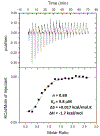HSP60/10 chaperonin systems are inhibited by a variety of approved drugs, natural products, and known bioactive molecules
- PMID: 30852084
- PMCID: PMC6450568
- DOI: 10.1016/j.bmcl.2019.02.028
HSP60/10 chaperonin systems are inhibited by a variety of approved drugs, natural products, and known bioactive molecules
Abstract
All living organisms contain a unique class of molecular chaperones called 60 kDa heat shock proteins (HSP60 - also known as GroEL in bacteria). While some organisms contain more than one HSP60 or GroEL isoform, at least one isoform has always proven to be essential. Because of this, we have been investigating targeting HSP60 and GroEL chaperonin systems as an antibiotic strategy. Our initial studies focused on applying this antibiotic strategy for treating African sleeping sickness (caused by Trypanosoma brucei parasites) and drug-resistant bacterial infections (in particular Methicillin-resistant Staphylococcus aureus - MRSA). Intriguingly, during our studies we found that three known antibiotics - suramin, closantel, and rafoxanide - were potent inhibitors of bacterial GroEL and human HSP60 chaperonin systems. These findings prompted us to explore what other approved drugs, natural products, and known bioactive molecules might also inhibit HSP60 and GroEL chaperonin systems. Initial high-throughput screening of 3680 approved drugs, natural products, and known bioactives identified 161 hit inhibitors of the Escherichia coli GroEL chaperonin system (4.3% hit rate). From a purchased subset of 60 hits, 29 compounds (48%) re-confirmed as selective GroEL inhibitors in our assays, all of which were nearly equipotent against human HSP60. These findings illuminate the notion that targeting chaperonin systems might be a more common occurrence than we previously appreciated. Future studies are needed to determine if the in vivo modes of action of these approved drugs, natural products, and known bioactive molecules are related to GroEL and HSP60 inhibition.
Keywords: Chaperonin; GroEL; GroES; HSP10; HSP60; Molecular chaperone; Natural products; Proteostasis; Small molecule inhibitors.
Copyright © 2019 The Authors. Published by Elsevier Ltd.. All rights reserved.
Figures




Similar articles
-
Exploiting the HSP60/10 chaperonin system as a chemotherapeutic target for colorectal cancer.Bioorg Med Chem. 2021 Jun 15;40:116129. doi: 10.1016/j.bmc.2021.116129. Epub 2021 Apr 19. Bioorg Med Chem. 2021. PMID: 33971488 Free PMC article.
-
Targeting the HSP60/10 chaperonin systems of Trypanosoma brucei as a strategy for treating African sleeping sickness.Bioorg Med Chem Lett. 2016 Nov 1;26(21):5247-5253. doi: 10.1016/j.bmcl.2016.09.051. Epub 2016 Sep 22. Bioorg Med Chem Lett. 2016. PMID: 27720295
-
GroEL/ES inhibitors as potential antibiotics.Bioorg Med Chem Lett. 2016 Jul 1;26(13):3127-3134. doi: 10.1016/j.bmcl.2016.04.089. Epub 2016 May 4. Bioorg Med Chem Lett. 2016. PMID: 27184767
-
Reaction Cycle of Chaperonin GroEL via Symmetric "Football" Intermediate.J Mol Biol. 2015 Sep 11;427(18):2912-8. doi: 10.1016/j.jmb.2015.04.007. Epub 2015 Apr 18. J Mol Biol. 2015. PMID: 25900372 Review.
-
Molecular chaperone GroEL/ES: unfolding and refolding processes.Biochemistry (Mosc). 2013 Dec;78(13):1405-14. doi: 10.1134/S0006297913130038. Biochemistry (Mosc). 2013. PMID: 24490731 Review.
Cited by
-
Transcriptome Analysis of Acinetobacter baumannii in Rapid Response to Subinhibitory Concentration of Minocycline.Int J Environ Res Public Health. 2022 Dec 1;19(23):16095. doi: 10.3390/ijerph192316095. Int J Environ Res Public Health. 2022. PMID: 36498165 Free PMC article.
-
Dual-targeting GroEL/ES chaperonin and protein tyrosine phosphatase B (PtpB) inhibitors: A polypharmacology strategy for treating Mycobacterium tuberculosis infections.Bioorg Med Chem Lett. 2019 Jul 1;29(13):1665-1672. doi: 10.1016/j.bmcl.2019.04.034. Epub 2019 Apr 24. Bioorg Med Chem Lett. 2019. PMID: 31047750 Free PMC article.
-
Hsp60 Post-translational Modifications: Functional and Pathological Consequences.Front Mol Biosci. 2020 Jun 4;7:95. doi: 10.3389/fmolb.2020.00095. eCollection 2020. Front Mol Biosci. 2020. PMID: 32582761 Free PMC article. Review.
-
Small Molecule Inhibitors Targeting the Heat Shock Protein System of Human Obligate Protozoan Parasites.Int J Mol Sci. 2019 Nov 25;20(23):5930. doi: 10.3390/ijms20235930. Int J Mol Sci. 2019. PMID: 31775392 Free PMC article. Review.
-
Exploiting the HSP60/10 chaperonin system as a chemotherapeutic target for colorectal cancer.Bioorg Med Chem. 2021 Jun 15;40:116129. doi: 10.1016/j.bmc.2021.116129. Epub 2021 Apr 19. Bioorg Med Chem. 2021. PMID: 33971488 Free PMC article.
References
-
- Hartl FU; Bracher A; Hayer-Hartl M Molecular chaperones in protein folding and proteostasis. Nature 2011, 475, 324–332. - PubMed
-
- Stefani M; Dobson CM Protein aggregation and aggregate toxicity: new insights into protein folding, misfolding diseases and biological evolution. J. Mol. Med. (Berl.) 2003, 81, 678–699. - PubMed
-
- Bao YP; Cook LJ; O’Donovan D; Uyama E; Rubinsztein DC Mammalian, yeast, bacterial, and chemical chaperones reduce aggregate formation and death in a cell model of oculopharyngeal muscular dystrophy. J. Biol. Chem 2002, 277, 12263–12269. - PubMed
Publication types
MeSH terms
Substances
Grants and funding
LinkOut - more resources
Full Text Sources
Other Literature Sources
Chemical Information
Research Materials
Miscellaneous

